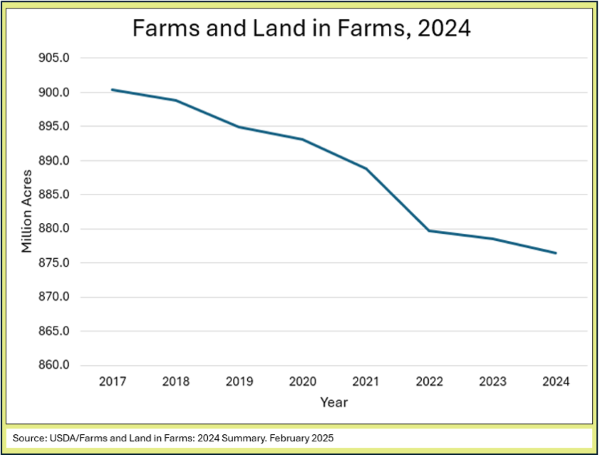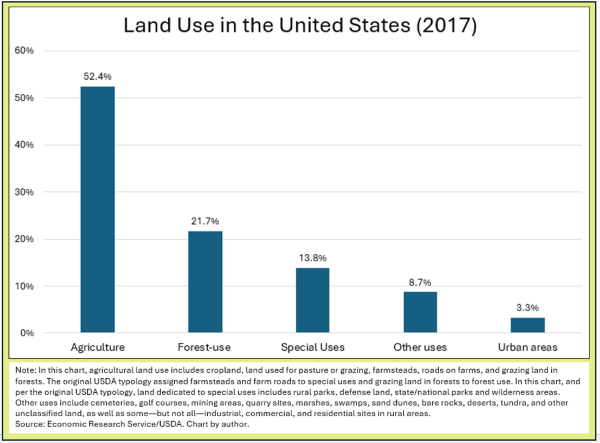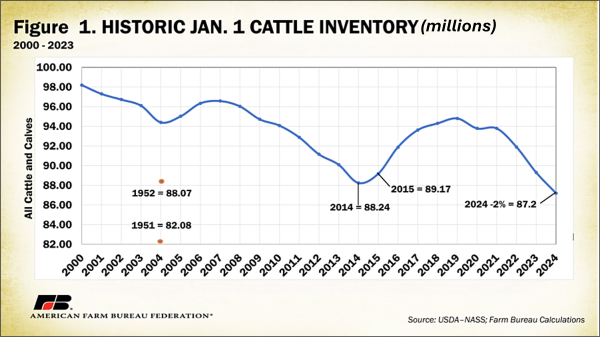“How much undeveloped land would be needed to put a million Americans in single family homes on lots of 5,000 sq feet, assuming 3 members per household? Roughly 25 individuals per acre, or about 40,000 acres in the entire US…Let’s assume all of those acres were developed at the urban fringe of densifying cities with a shortage of family housing and the land was bought from US farmers and ranchers.
This is not an unreasonable assumption: US farmers and ranchers have plenty of land to sell. Over the past 7 years alone, agricultural land in the US has decreased by 30 million acres, from 900 million acres in 2017 to 870 million in 2024…” - Rethinking Density: How to Protect Wild Habitat and Have a Yard Too/Exploring the Problem Space, May 9, 2025
For the record, 40,000 acres represents .13% of 30 million acres. That’s a bit over 1 acre of dense single family housing for every 1,000 acres of agricultural land retired over the past several years.
This chart documents the trend in US farmland:
Note: The USDA defines farmland broadly as any operation that produces agricultural goods with the potential to generate at least $1,000 in value annually. This includes a wide range of agricultural activities, from growing crops to raising livestock, and can include farms of various sizes and structures.
“Per the USDA , urban areas comprise only 3.3% of land use in America. Urban areas are not a major source of habitat loss in the U.S. That honor goes to agriculture, which takes up half of the land used in this country.”- Rethinking Density: How to Protect Wild Habitat and Have a Yard Too/Exploring the Problem Space, May 9, 2025
More on land use in the US:
Note: 2017 is the latest year a full land-use data set is available (published by USDA in 2024)
A single cow requires 1-2 acres a year (3-5 acres if grass-fed). One acre of single family homes on 5,000 sq ft lots could house around 25 people (assuming 3 residents per house, on average).
Luckily, cattle numbers are going down, freeing up land for nature and other uses.
Let’s hope the trend continues.
On a related note: in 2021, the US had 4.9 million acres of certified organic farmland. Organic agriculture is woefully bad for wild habitat. Why? Because it requires much more land to achieve the same yield as conventional farming. Specifically…
“Although generally presented otherwise organic agriculture (OA) is much less productive per unit area of land than conventional agriculture (CA) for two reasons. First, because the yields of individual crops grown in OA are generally less than those in CA. Second, because the reliance in OA on organic fertilizer, i.e. plant and animal manures, requires that additional land [to be] grown… The implications for food security and nature conservation place OA at a disadvantage because transformation to OA would require substantial expansion of agricultural land, e.g. an OA/CA ratio of 0.5, would require a doubling of area under OA to maintain equal production. By contrast, higher yields in CA reduce the demand for land in agriculture and consequently can conserve land for nature.” - Connor, D.J. Analysis of farming systems establishes the low productivity of organic agriculture and inadequacy as a global option for food supply. npj Sustain. Agric. 2, 2 (2024). https://doi.org/10.1038/s44264-023-00009-7
It’s true that organic farms typically support more biodiversity on the land being farmed than conventionally farmed intensive agriculture. But it’s also true that cultivated land, whether organically or conventionally farmed, is worse for biodiversity than wild habitat, so the less land farmed the better. Plus, intensive farms can do lots of stuff to increase biodiversity on their land, including minimal tillage, precision applications of pesticides and fertilizers, cover crops, buffer strips for pollinators and filter strips to protect water ecosystems from toxic runoff.
In other words, why not combine the best practices of organic and conventional farming*, releasing even more farmland to nature and other uses, including a bit for dense developments of single family homes?
—
* Along those lines:
“… combining conventional with OA [Organic Agriculture] practices enhances ecological processes which may reduce climate effects of agriculture. Overall, many conventional and OA practices are continuously evolving and rather than adhesion to fixed sets of principles, more sustainable and climate-resilient agricultural practices should be developed for site-specific implementation…”.- Lorenz, K., Lal, R. (2023). Combining Conventional and Organic Practices to Reduce Climate Impacts of Agriculture. In: Organic Agriculture and Climate Change


